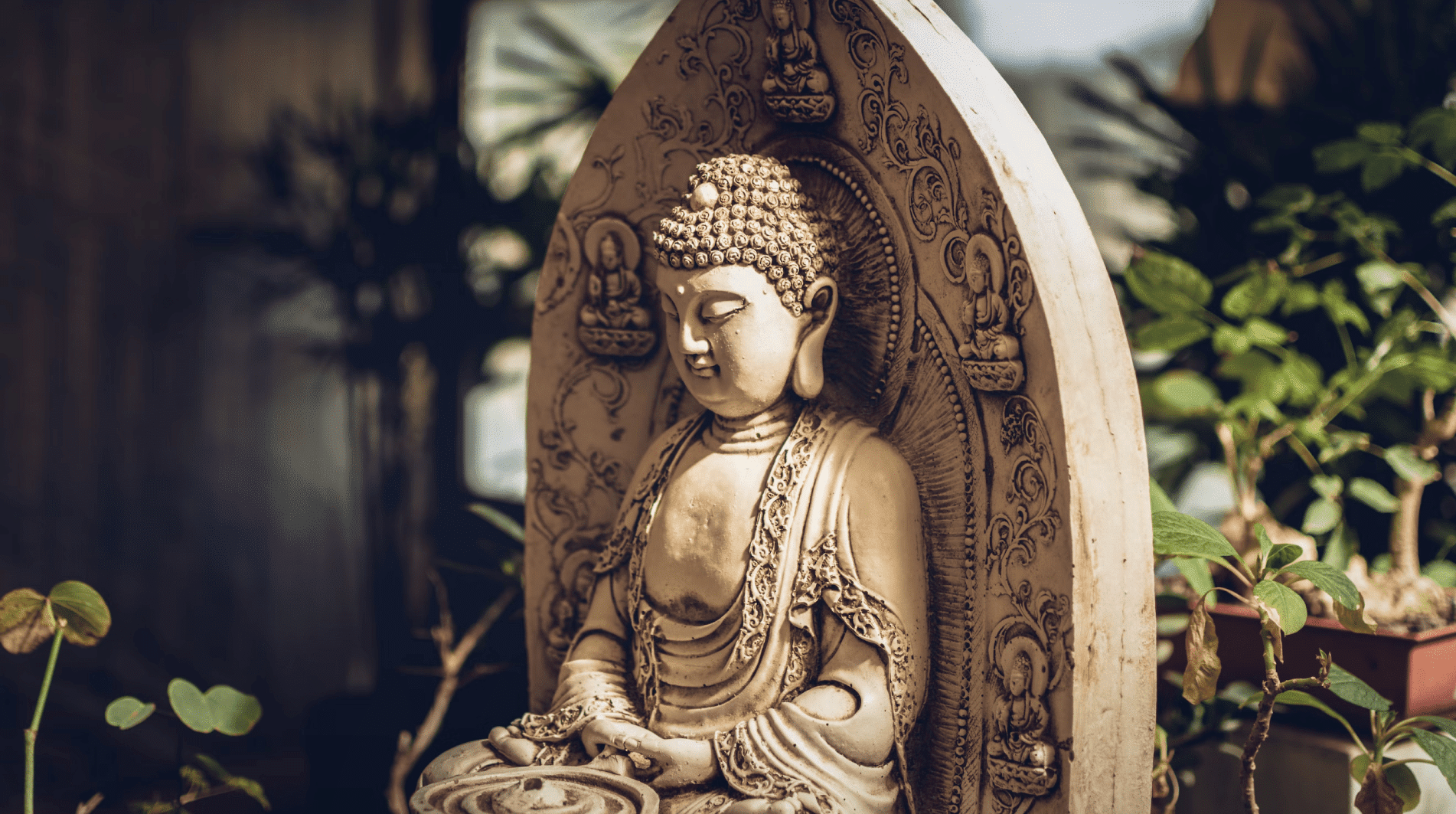
Ganesha, the beloved elephant-headed deity, holds a revered place in the hearts of millions across the globe. Known as the God of new beginnings and the remover of obstacles, Ganesha symbolizes wisdom, prosperity, and the ever-present potential for transformation.
As we delve into the enchanting world of Ganesha, we’ll explore his origins, his vital role in Hindu mythology, and how he inspires us to embrace change and overcome barriers in our lives.
The Symbolism of Ganesha
Ganesha, a deity frequently portrayed with an elephant head and a jolly pot belly, is replete with symbolic meaning. Every part of his form is a rich representation of deeper truths, reflecting a core facet of life and spirituality. The elephant head, for example, represents wisdom and comprehension. Ganesha personifies the intelligence and memory for which elephants are renowned. This symbolism motivates followers to live wisely, calmly, and thoughtfully, navigating life’s challenges.
Ganesha’s enormous ears are another essential feature. Ganesha’s ears serve as a reminder to listen more and speak less in a world full of noise and distractions, absorbing knowledge and comprehending the subtleties of our environment. His small eyes represent focus and the capacity to concentrate on the little things while maintaining a broader perspective on life. This emphasis on duality teaches us to strike a balance between the big picture and the small print.
In artistic representations, Ganesha is often depicted with multiple arms, each holding different objects that symbolize various attributes. For instance, the axe represents the cutting away of attachments and obstacles, while the lotus signifies spiritual growth and purity. The modak (sweet dumpling) in his hand symbolizes the rewards of a disciplined and devoted life. Additionally, the snake around his waist represents energy and protection. These elements together create a complex and meaningful portrayal of Ganesha’s divine nature.
Ganesha’s Origins and Mythology
The origin stories of Ganesha are as diverse and rich as the cultures that revere him. One of the most popular myths is that of his creation by Parvati, the consort of Lord Shiva. According to this legend, Parvati created Ganesha from the sandalwood paste she used for her bath and breathed life into him to guard her while she bathed. When Shiva returned and found an unknown boy guarding his abode, a battle ensued, resulting in Ganesha’s head being severed. To appease Parvati, Shiva replaced Ganesha’s head with that of an elephant, thus bringing him back to life.
Ganesha’s broken tusk powerfully symbolizes sacrifice and the ability to retain good while releasing negativity. According to mythology, he broke his tusk to painstakingly write the Mahabharata, demonstrating that wisdom frequently entails personal sacrifice. The trunk, which is adaptable and practical, represents versatility and effectiveness. The trunk serves as an example of the capacity to adjust to different circumstances with grace and effectiveness, whether it involves clearing obstacles or carrying out delicate chores. We can learn from this flexibility to maintain our composure when faced with life’s challenges.
If you want to dive deeper into this kind of embodied wisdom, East+West’s yoga teacher training in Bali and Costa Rica is a powerful next step.
Ganesha’s marriages to Riddhi (prosperity) and Siddhi (spiritual power) further symbolize his ability to bestow both material and spiritual wealth upon his devotees. These stories, while mythological, offer profound insights into human nature and the divine.
The Significance of Ganesha in Hindu Culture
In Hindu culture, Ganesha occupies a central place not just in religious practices but in the everyday lives of devotees. He is invoked at the beginning of any new venture, whether it’s a business, a journey, or a creative endeavor. This practice stems from the belief that Ganesha’s blessings can remove potential obstacles and ensure a smooth start. His role as Vighnaharta, the remover of obstacles, makes him an essential deity for anyone seeking success and prosperity.
Ganesha’s significance extends beyond personal endeavors to community and cultural events. Festivals like Ganesha Chaturthi, celebrated with great fervor across India, highlight his importance in uniting communities. These festivals involve elaborate rituals, public processions, and the installation of Ganesha idols, fostering a sense of collective joy and spirituality. The communal worship of Ganesha during these festivals underscores his role in bringing people together and promoting social harmony.
In the realm of arts and education, Ganesha is a patron. Students and artists often seek his blessings before embarking on their studies or creative projects. His association with wisdom and learning makes him a guiding figure for those in pursuit of knowledge. Schools, universities, and art institutions frequently have statues or images of Ganesha, symbolizing the aspiration for intellectual and artistic excellence. Through these varied aspects, Ganesha’s significance permeates all facets of Hindu culture.

Ganesha’s Role in New Beginnings
One of the most cherished aspects of Ganesha is his role in new beginnings. This is vividly exemplified by the practice of invoking his blessings at the start of any significant task. Whether it’s the inauguration of a new business, the commencement of a journey, or the beginning of a new academic year, Ganesha’s presence ensures a successful and obstacle-free start. This tradition is rooted in the belief that Ganesha, as the God of new beginnings, has the power to clear the path and provide the necessary wisdom and guidance.
The symbolism of Ganesha in new beginnings is also reflected in his presence during the Griha Pravesh (housewarming ceremony). When people move into a new home, they often perform a puja (ritual worship) to invoke Ganesha’s blessings. This ritual signifies the desire for a harmonious and prosperous life in the new dwelling. Similarly, Ganesha blesses couples during wedding ceremonies to ensure a smooth and happy married life. These practices highlight the deep-rooted cultural belief in Ganesha’s power to bestow auspicious beginnings.
Moreover, Ganesha’s role in new beginnings transcends the physical and material aspects of life. On a spiritual level, he represents the start of a new journey towards enlightenment and self-realization. Devotees turn to Ganesha when they embark on a spiritual quest, seeking his guidance to overcome the inner obstacles that hinder their progress. This spiritual dimension of Ganesha’s role underscores the holistic influence he has on both the external and internal facets of life. By invoking Ganesha, individuals seek not only material success but also spiritual growth and fulfillment.
How Ganesha Removes Obstacles
Ganesha’s epithet, Vighnaharta, literally means “remover of obstacles,” and this aspect of his divinity is central to his worship. Devotees believe that by invoking Ganesha’s blessings, they can overcome challenges and achieve their goals. Numerous myths and stories highlight Ganesha’s ability to clear the path for his followers, which roots this belief in tradition. For example, in the legend of the Syamantaka jewel, Ganesha aids in resolving misunderstandings and restoring peace, demonstrating his role in removing both physical and psychological obstacles.
The process of removing obstacles is not just about eliminating external challenges but also about addressing internal barriers. Ganesha’s wisdom and insight help devotees gain clarity and perspective, enabling them to navigate through life’s difficulties with confidence and grace. This dual approach—removing external obstacles and cultivating inner strength—is what makes Ganesha’s role so profound.
Rituals and practices dedicated to Ganesha often involve specific mantras and prayers aimed at seeking his intervention in removing obstacles. People often chant one of the most popular mantras, “Om Gan Ganapataye Namah,” to invoke Ganesha’s presence and ask for his help in overcoming difficulties. They also leave offerings like modaks (sweet dumplings), believed to be Ganesha’s favorite, to gain his favor. These rituals, while seemingly simple, are imbued with deep faith and devotion, reflecting the trust that devotees place in Ganesha’s ability to clear their path.

Celebrating Ganesha: Festivals and Rituals
Ganesha Chaturthi is perhaps the most widely celebrated festival dedicated to Ganesha. This festival marks the birth of the deity and is observed with immense enthusiasm and grandeur, especially in the Indian states of Maharashtra, Karnataka, and Andhra Pradesh. The celebrations typically last for ten days, beginning with the installation of elaborately crafted Ganesha idols in homes and public pandals (temporary structures). Devotees offer prayers, sing hymns, and perform aarti (ritual of worship with lights) to honor Ganesha and seek his blessings.
The festival culminates in the Visarjan (immersion) ceremony, when devotees take the idols in grand processions to rivers, lakes, or the sea and immerse them in the water. This ritual symbolizes Ganesha’s departure to his heavenly abode while taking away the misfortunes and obstacles of his devotees. The Visarjan is a spectacle of devotion and celebration, marked by vibrant processions, music, dance, and the collective chanting of “Ganapati Bappa Morya, Pudhchya Varshi Lavkar Ya” (O Lord Ganesha, come again early next year). This communal celebration fosters a sense of unity and shared spirituality.
Apart from Ganesha Chaturthi, other rituals and festivals also honor Ganesha. For instance, Sankashti Chaturthi, observed on the fourth day after the full moon, is dedicated to Ganesha and involves fasting and special prayers. Devotees believe that observing this fast and worshiping Ganesha on this day can help in overcoming obstacles and fulfilling desires. People also worship Ganesha during the Diwali festival, especially on the day of Lakshmi Puja, to invoke his blessings for wealth and prosperity. These diverse celebrations reflect the deep reverence and affection that devotees have for Ganesha across different regions and communities.

Popular Ganesha Mantras and Prayers
Mantras and prayers dedicated to Ganesha are integral to his worship and carry the power to invoke his blessings and protection. One of the most renowned mantras is the “Ganesh Gayatri Mantra,” which goes: “Om Ekadantaya Vidmahe, Vakratundaya Dheemahi, Tanno Danti Prachodayat.” This mantra honors Ganesha’s unique form and seeks his guidance and illumination. Chanting this mantra enhances focus, removes obstacles, and brings success in endeavors.
Another widely chanted mantra is “Om Gan Ganapataye Namah,” a simple yet powerful invocation that pays homage to Ganesha and requests his intervention in removing obstacles. People often recited this mantra at the beginning of important tasks or during times of difficulty, as it summons Ganesha’s presence and support. The repetition of this mantra fosters a sense of calm and assurance, helping devotees to face challenges with a positive and determined mindset.
If you want to dive deeper into this kind of embodied wisdom, East+West’s yoga teacher training in Bali and Costa Rica is a powerful next step.
In addition to mantras, prayers such as the “Ganesha Ashtottara Shatanamavali,” which lists 108 names of Ganesha, are also significant in his worship. Each name highlights a different aspect of Ganesha’s divine attributes, from his wisdom and strength to his compassion and benevolence. These mantras and prayers, whether chanted individually or in groups, serve as a conduit for connecting with Ganesha’s divine energy and seeking his guidance in life’s journey.
Embracing Ganesha’s Teachings in Daily Life
Ganesha’s wisdom encourages us to seek knowledge and understanding, to listen more and speak less, and to approach life’s challenges with a calm and focused mind. By embodying these qualities, we can navigate through the complexities of life with greater ease and resilience.
Ganesha’s role as the remover of obstacles teaches us the importance of facing our challenges head-on and seeking solutions with determination and faith. Whether it’s through chanting his mantras, performing rituals, or simply invoking his presence in our thoughts, we can draw strength and guidance from Ganesha to overcome difficulties and achieve our goals. His teachings remind us that obstacles are not just external barriers but also internal ones, and by cultivating inner strength and clarity, we can transform our lives.
Celebrating Ganesha through festivals, rituals, and art allows us to connect with his divine energy and experience a sense of unity and shared spirituality. These practices not only honor Ganesha but also foster a sense of community and collective joy. By embracing Ganesha’s teachings and invoking his blessings, we can infuse our lives with wisdom, prosperity, and the ever-present potential for transformation. In doing so, we pave the way for success, peace, and fulfillment in our daily endeavors.
















